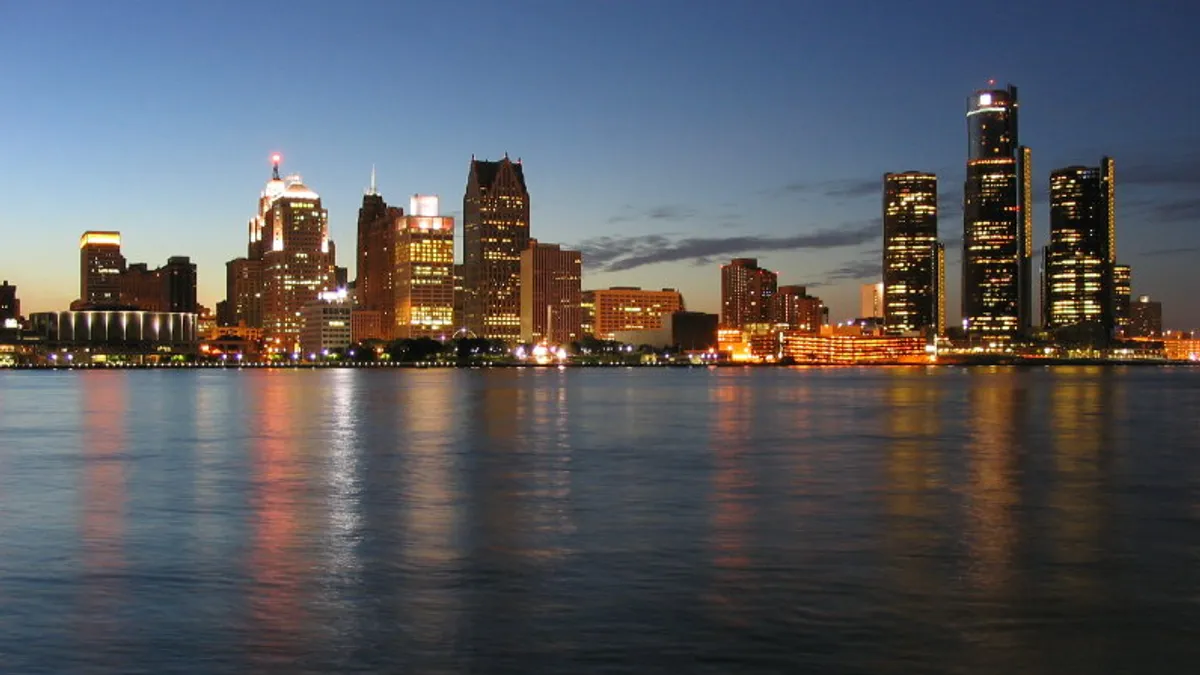UPDATE, July 23, 2018: The proposed tax millage to fund a regional transit plan in Southeast Michigan will not be on the ballot in November, according to the Detroit Free Press and others.
The Free Press reported that despite support from leaders in Washtenaw and Wayne Counties and the City of Detroit, their counterparts in Macomb and Oakland Counties were not on board. Negotiations will continue, with a view to trying to have it on the ballot in 2019.
Paul Hillegonds, chair of the board of the Regional Transit Authority of Southeast Michigan, said he was disappointed, but that he believed the region will have a transit plan. "I don't know when that will be," he said, according to the Free Press.
There had been broad support for the regional transit plan, including among 23 CEOs of businesses from the Detroit metropolitan area and from local hospital leaders, who said the lack of transit options endangered public health.
Dive Brief:
- Wayne County Executive Warren Evans has proposed a massive, re-worked transit plan, called Connect Southeast Michigan, for the Detroit metro area, which would replace the regional transit master plan that citizens narrowly voted down on the 2016 ballot. The new plan will go to voters if the board of the Regional Transit Authority (RTA) of Southeast Michigan approves it.
- The plan calls for a 1.5 mill property tax levy for citizens in four neighboring counties, which would raise $5.4 billion over 20 years. By law, 85% of the tax revenue would be invested in the county from which it was collected.
- The plan would invest in new bus routes, express bus routes, bus stations, traffic signal upgrades, road improvements, park-and-ride lots and ride-sharing partnerships. One of the big-ticket items is a new commuter rail service between Detroit and Ann Arbor, which are about 40 miles apart.
Dive Insight:
As one might expect for an automobile-centric place dubbed "Motor City," the Detroit metropolitan area has been slow to adopt and expand modern transit. Evans claims that the lack of regional transit was a deal breaker for Amazon, causing the company to overlook Detroit as one of its top 20 finalists for HQ2.
Although the city center has some transit, it doesn't serve greater metro Detroit residents very well. That's a problem considering that about 673,000 people live in Detroit, but about 4.3 million live in the metro area. A lack of comprehensive transit leaves the majority of the region's population dependent on cars.
The primary mode of public transportation in Detroit is the bus, and that system is less robust than in other major cities. The Central Business District has a short, elevated monorail loop, the People Mover, that is largely not viewed as a viable transit option.
Last May the city started running its streetcar, the QLine, a 3.3-mile, 20-stop line in the heart of the city. The QLine kept expanding its timeline for offering free rides and then began charging fares in the fall; ridership promptly dropped by 40% after the fares kicked in. The QLine has faced criticism for being a largely standalone transit option that doesn't connect to the existing bus system, and for excluding underserved and low-income populations.
The new transit proposal aims to connect some of those underserved residents, especially those outside of urban centers, with low-cost transit options. It would increase bus availability as well as frequency, to ensure that metro Detroit buses arrive every 15 minutes from 6 a.m. to 8 p.m. on prime routes, and at that interval during peak hours on other routes. The 15 new express routes would primarily target commuters and those traveling to and from Detroit's airport, which is about 20 miles from downtown and doesn't have good transit options.
When the previous transit proposal was voted down in 2016, it was only by a small margin, 50.5% to 49.5%. But that plan had a lower proposed millage, a 1.2 mill tax as opposed to the newly proposed 1.5 mill. But instead of focusing more on bus rapid transit and rail like the last ballot measure, the new proposal mostly targets improving and expanding the existing bus system. Communities that do not have regularly-scheduled bus routes would get investments in creative transit solutions such as public-private ride-sharing partnerships.
Opponents believe a tax increase will be hard for citizens to swallow, especially those still suffering from Detroit's economic slide a number of years ago. Some residents in Detroit's surrounding counties also feel that they don't get the same amount of return from these plans even though they pay the same tax as those in urban centers. But proponents say this proposal presents options to serve rural residents far better than the previous plan.
To get the proposal on the ballot in November, RTA has to hold a public hearing and then approve the plan.













